Understanding the Limitations of Vision Insurance: Maximizing Your Optical and Vision Care Benefits
When it comes to taking care of our eyesight, many of us rely on vision insurance to help us cover the costs of important exams and treatments. However, it’s important to understand that like many types of insurance, vision insurance may come with certain limitations.
Before you sign up for a vision insurance plan, it’s important to do your research and understand exactly what it covers, what it doesn’t cover, and what restrictions or limitations may apply. In this article, we’ll take a closer look at some of the most common limitations of vision insurance plans and what you can do to make sure you’re getting the care you need.
Coverage Limits
One of the most important things to understand about your vision insurance plan is its coverage limits. While some plans offer comprehensive coverage that can be used to pay for everything from routine eye exams to more complex treatments, other plans may come with more limited coverage that only covers basic exams and glasses or contacts.
For example, some plans may limit you to one exam per year or may only cover glasses or contacts up to a certain amount. If you require more frequent exams or have a more severe vision issue that requires specialized treatment, you may find that your insurance doesn’t cover all of your needs.
Network Restrictions
Another common limitation of vision insurance is network restrictions. Like other types of insurance, vision insurance plans often work by partnering with specific providers or networks. If you choose to see an out-of-network provider, you may face higher fees or may not be covered at all.
It’s important to understand the details of your network and which providers are covered under your plan. This can help you avoid unexpected fees or uncovered expenses.
Tip:
Make sure you check with your insurance provider before scheduling any appointments to confirm that the provider is covered by your plan.
Preexisting Conditions
Another limitation to be aware of when it comes to vision insurance is related to preexisting conditions. Some plans may not cover certain conditions that were present before you enrolled in the plan. This can be especially concerning if you have a condition that requires ongoing care or treatment.
It’s important to review the details of your plan carefully to understand what preexisting conditions are covered and which are not. In some cases, you may need to consider supplemental insurance or other options to help cover the costs of ongoing care.
Final Thoughts
While vision insurance can be a great way to offset the costs of important care and treatment, it’s important to understand that there may be certain limitations to your coverage. By taking the time to review your plan details and understand what is covered and what is not, you can make sure that you’re getting the care you need without breaking the bank.
- Check your coverage limits
- Understand your network restrictions
- Review your preexisting condition coverage
With these tips in mind, you can make informed decisions about your vision care and ensure that you have coverage that meets your needs.
Most wanted in Hoya Vision:
What brand lenses does Costco use?
Hoya Lens Engravings
Why do my glasses lenses scratch so easily?
Which lens is better Alcon or Johnson and Johnson?
What’s the rarest eye color?
Visionworks Digital Progressive Lenses
Should eyeglasses cover eyebrows?
How to Choose the Right Temple Type for Your Glasses
Workspace Lenses
Hoya Sensity Vs Transitions Xtractive
















